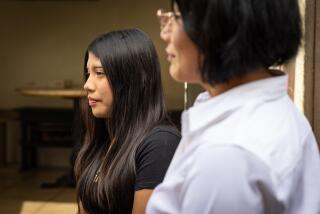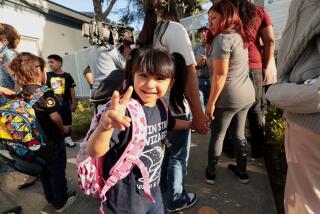Learning Curve
- Share via
In Lori Peters’ classroom, there are no desks. The students are free to sit wherever they want, except during afternoon “circle time,” when they gather on a rug and talk about resolving conflicts and making decisions.
And throughout the day, students ages 9 to 11 work on school assignments at their own speed.
Peters’ room is an “open classroom,” a nontraditional teaching program where students are grouped by skill rather than age.
The concept is not new. Open classrooms, which advocates say promote student choice and responsibility, started appearing throughout California in the 1960s.
In the last decade, some districts reversed the liberal trend and created fundamental schools, which emphasize rigid homework regimens, dress codes and heavy drills in phonics and mathematics.
But open classrooms are surviving--and thriving--in a few county schools. Five of the 25 classrooms at Conejo Elementary School in Thousand Oaks offer the freestyle teaching method. Ventura’s Blanche Reynolds Elementary School, among the first in the county to offer such a program, has three.
And nine rooms at Camarillo’s Bedford Open School and 28 rooms at Park View Elementary School in Simi Valley use a similar method that emphasizes teaching students at their level.
“Too many classrooms focus on all kids doing the same thing at the same time,” Peters said. “Open classrooms are really individualized.”
In fact, more districts might embrace open classrooms as unsatisfied parents continue to press for new ways to teach their children. There are frequently waiting lists for the open classrooms, indicating that demand is not being met.
What parents like about open classrooms--and many are passionate about the benefits--is the ability to create a nurturing learning environment that can be tailored to the specific needs of each student.
Though the teachers work within district- and state-approved lessons, they have the freedom to develop their own creative, hands-on activities. Students learn at their own pace, advocates say. For example, a fourth-grader might be reading with sixth-graders but doing math at a second-grade level.
But critics of open classrooms say students have too much freedom and don’t spend enough time on the basics. They contend that a good teacher in a traditional classroom can address individual students’ needs.
Leslie Frank, principal of Hollow Hills Fundamental School in Simi Valley, said structure helps a child learn reading, math, science and social studies, particularly in the early grades.
“In a pure self-directed program, a child may miss some of that basic core knowledge,” Frank said.
But teachers say they do offer some guidance for their students, whom they say often perform above average on statewide achievement tests. And because the students have to make choices, they are better prepared for middle school--and life, teachers say.
“We’re not constantly putting parameters on them,” Peters said. “Rather than me telling them when to take out pencils and paper, they have to make decisions by themselves. The kids have to take responsibility for their learning.”
All students are eligible to enroll in an open classroom, but some parents say the method is particularly effective for smart students and those who need extra help. That is because the children can work at their own level, rather than doing the grade-level assignments they would be required to do in a traditional classroom.
Brenda Yoshinaga placed her two children, both classified as highly intelligent, in Conejo’s open classrooms. She said the teachers challenge the kindergartner, who reads at an advanced level, but still allow her to be a little girl.
The programs rely on parent participation. Conejo Elementary parents must volunteer a few hours each week. They can spend that time doing a variety of activities, such as teaching mini-lessons, grading homework, planning field trips or reading with students.
On a recent day, parents wandered in and out of Colleen Briner Schmidt’s open class at Conejo. At first glance, the classroom appeared chaotic, with children ages 5 and 6 scattered everywhere.
But the students all knew where they were supposed to be and what they were supposed to be doing. Some wrote in their journals. Several cut up paper into fractions. A few read with a parent volunteer.
“There is really a free flow of learning,” said Debbie Bavaro, a Conejo Elementary parent volunteer. “In a regular classroom, the lesson plan begins and ends. Here the lesson begins and doesn’t end.”
The lack of desks encourages creative learning, advocates say, because students make their own choices about where to sit. Teachers also say the open space allows them to form small groups based on their ability in math, language or other subjects.
In Conejo’s open classrooms, the students write on clipboards, which they carry around the classroom. During a geography quiz, some of Peters’ students sat cross-legged on the floor, while others worked at a long table near the wall of the classroom.
Conejo’s program began six years ago when parents and teachers who wanted a different approach to teaching initiated the alternative classrooms. Initially, there were only two teachers and 35 students, Schmidt said. Now, there are five teachers, 115 students and a waiting list.
The program pulls kids, whose parents are willing to drive them there, from throughout the Conejo Valley Unified School District. The teachers decide in which class to place students based on their ability and maturity.
Often, students stay with the same teacher for several years. Because students of all different ages work together, teachers say, the classrooms foster a sense of friendship and cooperation. Supporters also say that children of different ages can learn from each other.
Lilly Ware, 10, said she likes the freedom to sit wherever she wants and to work at her own speed.
“I like to do harder work,” she said. “Here, you can go at your own pace. It seems to prepare you for life more because you are going to have a lot of responsibility when you are older.”
Programs elsewhere in the county are slightly different, but still promote kids learning at their own speed.
At Bedford Open School, the 205 students are divided into different grades but are given a lot of choices and responsibilities. At Park View School, the 630 students are also more self-directed than they would be in traditional classrooms. And teachers collaborate to tailor material for each student.
“For kids to be doing things they already know is a waste of time,” said Park View Principal Robin Hunter. “And for kids to be doing things that are way above their level is also a waste of time.”
More to Read
Sign up for Essential California
The most important California stories and recommendations in your inbox every morning.
You may occasionally receive promotional content from the Los Angeles Times.










